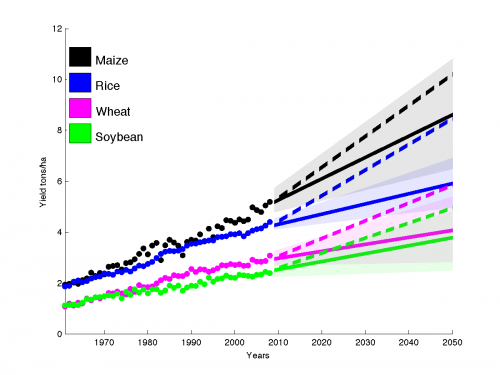Yield trends insufficient to double global crop production by 2050

Crop yields worldwide are not increasing quickly enough to support estimated global needs in 2050, according to a study published June 19 in the open access journal PLOS ONE by Deepak Ray and colleagues from the Institute on the Environment (IonE) at the University of Minnesota.
Previous studies estimate that global agricultural production may need to increase by 60-110% to meet increasing demands and provide food security. In the current study, researchers assessed agricultural statistics from across the world and found that yields of four key crops- maize, rice, wheat and soybean- are increasing at rates between 0.9 -1.6 percent every year. At these rates, production of these crops would likely increase 38-67 percent by 2050, rather than the estimated requirement of 60-110 percent. The top three countries that produce rice and wheat were found to have very low rates of increase in crop yields.
"Particularly troubling are places where population and food production trajectories are at substantial odds," Ray says, "for example, in Guatemala, where the corn-dependent population is growing at the same time corn production is declining."
The analysis maps global regions where yield improvements are on track to double production by 2050 and areas where investments must be targeted to increase yields. The authors explain that boosting crop yields is considered a preferred solution to meet demands, rather than clearing more land for agriculture. They add that additional strategies like reducing food waste and changing to plant-based diets can also help reduce the large estimates for increased global demand for food.
"Clearly, the world faces a looming agricultural crisis, with yield increases insufficient to keep up with projected demands," says IonE director Jon Foley, a co-author on the study. "The good news is, opportunities exist to increase production through more efficient use of current arable lands and increased yield growth rates by spreading best management practices. If we are to boost production in these key crops to meet projected needs, we have no time to waste."
More information: Ray DK, Mueller ND, West PC, Foley JA (2013) Yield Trends Are Insufficient to Double Global Crop Production by 2050. PLoS ONE 8(6): e66428.doi:10.1371/journal.pone.0066428
Journal information: PLoS ONE
Provided by Public Library of Science



















